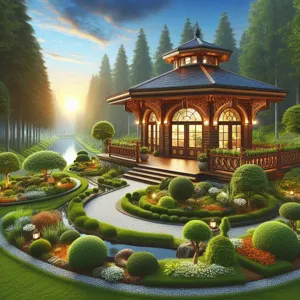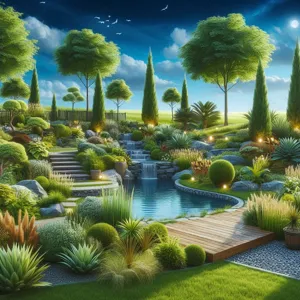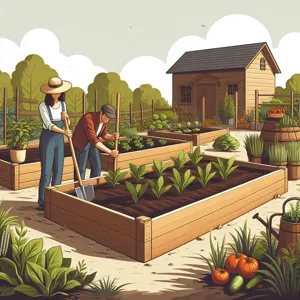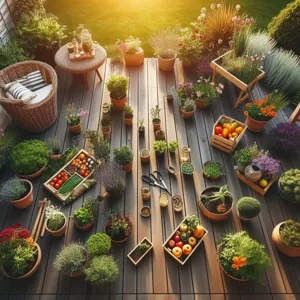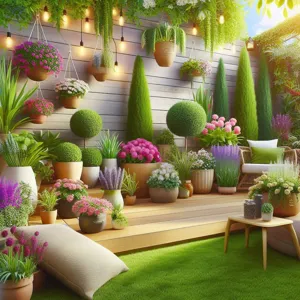Gardening is a rewarding endeavor that connects us to nature, nurtures our creativity, and provides fresh produce right from our own backyards.
For beginners, the thought of starting a garden can feel overwhelming, but building a simple raised garden bed is a perfect way to ease into this fulfilling hobby. Raised beds not only enhance drainage and soil quality but also create a defined space that minimizes weeds and pests, making gardening more manageable for newcomers. In this step-by-step guide, we’ll walk you through the entire process—from selecting the right location and materials to filling your bed with nutrient-rich soil and planting your first seeds. Whether you’re dreaming of vibrant vegetables, fragrant herbs, or colorful flowers, this guide will equip you with the knowledge and confidence to cultivate your green thumb and transform your outdoor space into a thriving garden oasis. So grab your tools and let’s get started on this journey toward homegrown success!
1. Introduction to Raised Garden Beds

Raised garden beds have surged in popularity among gardening enthusiasts and novices alike, and for good reason. They offer a multitude of benefits that transform the gardening experience into something more accessible and enjoyable. Imagine a garden that not only enhances the aesthetic of your outdoor space but also provides a more manageable way to grow your favorite vegetables, herbs, and flowers.
At their core, raised garden beds are essentially soil-filled boxes elevated above the ground. This design improves drainage, allows for better soil quality, and minimizes the risk of soil compaction, which can be a common issue in traditional in-ground gardens. By elevating the growing surface, raised beds also reduce the strain on your back and knees, making gardening a less physically taxing activity—a significant advantage for those with mobility concerns or anyone simply looking to enjoy their time outdoors without discomfort.
Moreover, raised garden beds can create a controlled environment for plants, protecting them from pests and weeds while allowing for optimal sunlight exposure. The versatility of these beds is astounding; they can be constructed in various sizes, shapes, and materials, accommodating any space from small urban balconies to expansive backyards.
In this guide, we will walk you through each step to create your very own raised garden bed, ensuring you have the tools and knowledge necessary to cultivate a flourishing green space. Whether you’re dreaming of vibrant tomatoes, fragrant basil, or colorful flowers, a raised garden bed can be the perfect solution to kickstart your gardening journey. Let’s dig in and explore the wonderful world of raised gardening!
2. Benefits of Building a Raised Garden Bed
Building a raised garden bed is not just a trend; it’s a smart investment in your gardening journey that offers a multitude of benefits. For starters, raised garden beds provide better drainage than traditional in-ground gardens. This is especially advantageous in areas with heavy clay soil or poor drainage, as the elevated structure allows excess water to flow away, reducing the risk of root rot and promoting healthier plants.
Moreover, the soil in raised beds warms up faster in the spring, allowing you to plant earlier and enjoy a longer growing season. This is a boon for gardeners eager to get a head start on their favorite vegetables or blooms. The defined borders of a raised bed also make it easier to manage soil quality, as you can fill it with a tailored blend of compost, topsoil, and other organic materials, creating the perfect environment for your plants to thrive.
Raised garden beds offer an ergonomic advantage as well, elevating the gardening surface to a comfortable height that reduces the need for bending and kneeling. This can make gardening accessible for individuals of all ages and abilities, ensuring that everyone can enjoy the therapeutic benefits of nurturing plants. Furthermore, the enclosed space helps to deter pests, as many critters will have a harder time accessing your plants.
Lastly, raised garden beds add an aesthetic appeal to your outdoor space. They can be constructed from a variety of materials, such as wood, stone, or recycled materials, and can be designed to fit any garden style. Whether you’re aiming for a rustic look or a more modern aesthetic, raised beds can enhance the visual charm of your yard while providing an organized and productive gardening area.
In summary, the benefits of building a raised garden bed are numerous: improved drainage, better soil management, ergonomic gardening, pest deterrence, and enhanced beauty. It’s a practical and rewarding choice for any beginner gardener looking to cultivate a thriving garden with ease.
3. Choosing the Right Location for Your Garden Bed

Choosing the right location for your raised garden bed is crucial to the success of your gardening endeavor. The positioning of your bed can significantly impact the growth of your plants, so it’s important to take some time to evaluate your options before you start building.
Start by observing the sunlight patterns in your yard. Most vegetables and flowering plants thrive on at least six to eight hours of direct sunlight each day, so look for a space that receives ample sunlight throughout the day. Avoid shaded areas near tall trees, fences, or buildings that can block the sun, as this can stunt the growth of your plants and lead to disappointing yields.
Next, consider the drainage of the area. Plants are susceptible to root rot if they sit in waterlogged soil, so ensure the spot you choose has good drainage. Look for a location that is slightly elevated or has well-draining soil. If your desired spot tends to collect water after rainfall, you might need to amend the soil or think about a different location.
Proximity to water is another factor to consider. A convenient water source will make it much easier to keep your garden bed hydrated, especially during the hot summer months when plants require more water. If your chosen spot is far from a hose or water outlet, consider how you will transport water to the bed or install a drip irrigation system for convenience.
Lastly, think about accessibility. You’ll want to ensure that your garden bed is easy to access for planting, weeding, and harvesting. Position it where you can easily reach all sides without trampling on the soil, which can compact it and hinder plant growth. If you plan to build multiple beds, consider arranging them in a way that allows you to walk comfortably between them.
By carefully selecting the right location for your raised garden bed, you set the stage for a thriving garden that will provide you with fresh produce and a sense of accomplishment. Happy gardening!
4. Selecting Materials: Wood, Composite, or Metal?
When it comes to building a raised garden bed, selecting the right materials is crucial for ensuring longevity, aesthetics, and the overall health of your plants. The three most popular options are wood, composite materials, and metal, each offering distinct advantages and considerations.
**Wood** is often the go-to choice for many gardeners due to its natural appearance and versatility. Cedar and redwood are particularly favored because they are naturally resistant to rot and pests. Pressure-treated lumber, while more affordable, can contain chemicals that may leach into the soil, so it’s advisable to line the interior of the bed with landscape fabric if you choose this option. When selecting wood, consider the thickness and durability, as thicker boards will withstand the elements better and provide a longer-lasting structure.
**Composite materials** have gained popularity in recent years as a durable alternative to traditional wood. Made from a blend of recycled plastics and wood fibers, composite boards resist rot, warping, and insect damage. They come in a variety of colors and textures, allowing you to choose a look that complements your garden design. However, keep in mind that composite materials can be more expensive than wood, so budget considerations are essential.
**Metal** raised beds, typically constructed from galvanized steel or corrugated metal, are another option to consider. Known for their modern aesthetic and durability, metal beds can withstand the elements and are less prone to decay. They heat up quickly in the sun, which can be beneficial for plants that thrive in warmer conditions. However, metal can also retain heat, so it’s important to keep an eye on soil temperatures, especially in hot climates. Additionally, ensure that the metal is of good quality to prevent rusting over time.
Ultimately, the choice of material will depend on your budget, aesthetic preferences, and the specific needs of your garden. By weighing the pros and cons of each type, you can select the best option that aligns with your gardening goals, ensuring your raised garden bed becomes a thriving sanctuary for your plants.
5. Tools You’ll Need for the Project

When embarking on the adventure of building a simple raised garden bed, having the right tools at your disposal can make the process smoother and more enjoyable. Here’s a comprehensive list of essential tools you’ll need to gather before you start your project:
1. **Measuring Tape**: Precision is key in any construction project, and a good measuring tape will help you ensure that your garden bed is the right size. Aim for a length that suits your space, typically between 4 to 8 feet, and a width of 2 to 4 feet.
2. **Level**: A level will help you ensure that your raised bed is even, which is crucial for proper drainage and plant growth. An uneven surface can lead to water pooling in one area, creating challenges for your plants.
3. **Saw**: Depending on your chosen materials, a saw will be necessary for cutting wood to the desired lengths. A circular saw is efficient for larger boards, while a handsaw might be more manageable for smaller cuts.
4. **Drill**: A power drill will save you time and effort when it comes to assembling your garden bed. You’ll need it to make pilot holes and drive screws into the wood. If you’re using treated lumber, ensure you have the appropriate drill bits to handle the material.
5. **Screwdriver**: While a drill can take care of most of the work, a screwdriver is handy for any tight spots or adjustments that may arise during assembly.
6. **Hammer**: If you’re using nails to secure your wood instead of screws, a good hammer will be essential. It’s also useful for tapping pieces into place as you build.
7. **Garden Gloves**: Protecting your hands is crucial when working with wood and soil. A sturdy pair of garden gloves will not only keep your hands clean but also shield them from splinters and rough edges.
8. **Trowel**: Once your bed is built and ready for planting, a trowel will be invaluable for digging, planting, and mixing soil. It’s a small yet mighty tool that every gardener should have on hand.
9. **Wheelbarrow**: If you’re planning to fill your raised bed with soil, compost, or other amendments, a wheelbarrow will make transporting materials much easier. It saves you from making multiple trips and will cut down on the physical strain.
10. **Rake**: After filling your raised bed, a rake can help level the soil and break up any clumps, ensuring a smooth, even surface for your plants.
Gathering these tools before you start your project will set you up for success and make the building process more enjoyable. With everything in place, you’ll be well on your way to creating a flourishing garden bed that yields delicious produce or vibrant flowers for years to come!
6. Planning Your Garden Bed Dimensions
When it comes to building a raised garden bed, taking the time to plan your garden bed dimensions can make all the difference in your gardening experience. The size and shape of your bed will not only affect the aesthetics of your garden but also play a crucial role in the types of plants you can grow and how easily you can maintain them.
To start, consider the space you have available. Raised garden beds can be built in a variety of dimensions, but a common size is 4 feet wide by 8 feet long. This size allows for ample growing space while still being manageable for most gardeners. The 4-foot width is particularly important, as it enables you to reach the center of the bed without stepping on the soil, which helps maintain soil structure and fertility.
Depth is also a vital consideration. A depth of 12 to 18 inches is generally recommended, as this provides sufficient room for root systems to establish themselves while allowing for good drainage. If you’re planning to grow larger plants such as tomatoes or carrots, opting for a deeper bed can be beneficial.
Don’t forget about accessibility! If you plan to garden with children or those with mobility issues, consider building shorter beds or incorporating paths between them to make reaching your plants easier. Also, think about the placement of your garden bed – ideally, it should receive at least 6-8 hours of sunlight each day, and be situated near a water source for convenient irrigation.
Finally, sketching out your design on paper can help visualize the layout. Consider adding compartments for different plants based on their watering and sunlight needs, or even designing a tiered garden bed for added dimension and interest. By thoughtfully planning your garden bed dimensions, you’ll set yourself up for a successful and enjoyable gardening experience. Happy gardening!
7. Preparing the Site: Clearing and Leveling the Ground
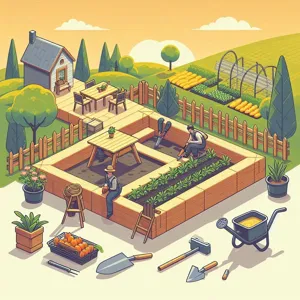
Before you dive into building your raised garden bed, it’s essential to ensure that the site is perfectly prepared. This step is crucial as it lays the foundation for a thriving garden. Start by selecting a location that receives ample sunlight—ideally, 6 to 8 hours a day—while also considering proximity to a water source for easy access during dry spells.
Once you’ve chosen your spot, it’s time to clear the area. Remove any grass, weeds, or debris that might compete with your plants for nutrients and water. Use a shovel or a hoe to dig up the sod, making sure to get beneath the roots to prevent any pesky plants from sprouting back up. If you encounter large rocks or roots, don’t hesitate to remove them, as these can hinder the growth of your garden.
After the area is cleared, it’s important to level the ground. A flat surface ensures proper drainage and prevents water from pooling in one area, which can lead to root rot. To achieve this, use a rake to smooth out the soil and check for any low spots. If you find any, fill them in with additional soil or compost to create an even surface.
For even greater precision, you can use a level or a straight board to check your progress. Stand back and visually assess the area, ensuring it’s as flat as possible. This step might seem tedious, but taking the time to prepare the site thoroughly will pay off in the long run, as your plants will be healthier and more productive. With a cleared and leveled area ready, you’re one step closer to building the perfect raised garden bed!
8. Step-by-Step Assembly Instructions
### Step-by-Step Assembly Instructions
Now that you have all your materials gathered and are ready to dive into the assembly process, it’s time to bring your raised garden bed to life. Follow these straightforward steps to ensure a smooth and successful construction.
**Step 1: Prepare Your Location**
Begin by selecting a level area in your yard that receives ample sunlight—ideally, at least six hours a day. Clear the space of any grass, weeds, or debris, and measure out the dimensions of your garden bed. If you’re using a rectangular design, mark the corners with stakes and string.
**Step 2: Cut Your Lumber**
Using a saw, cut your lumber to the desired lengths. For a typical 4×4-foot raised bed, you will need four pieces for the sides: two at 4 feet and two at 2 feet. Make sure to wear safety goggles and gloves for protection. If you prefer, many home improvement stores will cut the lumber for you at no extra charge.
**Step 3: Assemble the Frame**
Lay the two longer pieces of lumber parallel to each other. Position the shorter pieces between them to form a rectangle, ensuring that the corners are flush. Secure the corners using wood screws or brackets. If you’re using untreated wood, consider applying a wood preservative to extend its lifespan.
**Step 4: Reinforce the Structure**
To add stability to your raised bed, install corner brackets or add additional screws along each side. This will help prevent the wood from bowing over time as it fills with soil. If you’re feeling particularly ambitious, you can also add a center support beam for extra strength.
**Step 5: Position the Bed**
Once your frame is assembled, carefully lift it into place in your chosen location. Check that it remains level and adjust as needed. If it’s a larger bed, it may be helpful to enlist a friend to assist with lifting and positioning.
**Step 6: Fill with Soil**
With your frame in place, it’s time to fill the bed with soil. A mixture of topsoil, compost, and well-rotted manure works wonders for growing healthy plants. Fill the bed to the top, leaving room for watering, and gently level the surface.
**Step 7: Plant Your Seeds or Seedlings**
Now comes the fun part! Plan your garden layout and start planting your seeds or seedlings according to their spacing requirements. Be sure to follow specific planting instructions for each type of plant to ensure optimal growth.
**Step 8: Water and Maintain Your Garden**
Once your plants are in the ground, give them a good watering. Moving forward, keep an eye on moisture levels and be sure to regularly check for weeds and pests. With a little care and attention, your raised garden bed will thrive, providing a bountiful harvest for seasons to come.
Building a raised garden bed is not just a project; it’s an investment in your gardening journey. With these simple assembly instructions, you’re well on your way to cultivating your very own green oasis right in your backyard! Happy gardening!
9. Adding a Weed Barrier and Drainage
Once your raised garden bed is constructed and positioned to take advantage of sunlight, it’s time to focus on an often-overlooked but crucial aspect: adding a weed barrier and ensuring proper drainage. This step plays a vital role in maintaining the health of your plants and minimizing maintenance efforts throughout the growing season.
Start by lining the bottom of your raised bed with a weed barrier fabric. This permeable material acts as a protective shield against pesky weeds that would otherwise compete with your plants for nutrients, water, and sunlight. Make sure the fabric covers the entire base of the bed and extends up the sides slightly. Not only does this prevent weeds from pushing through the soil, but it also allows for moisture to pass through while keeping unwanted plants at bay.
Next, consider the drainage aspect of your garden bed. Proper drainage is essential to prevent waterlogging, which can lead to root rot and other plant diseases. If your bed sits in an area prone to heavy rain or if you notice water pooling, you might want to add a layer of coarse gravel or small stones at the bottom before placing the weed barrier. This will help facilitate drainage and ensure that excess water can escape easily.
Once the gravel is in place and covered with the weed barrier, you’re ready to fill your raised garden bed with a nutrient-rich soil mix. This combination of topsoil, compost, and other organic materials will provide the perfect environment for your plants to thrive. By taking these steps to add a weed barrier and consider drainage, you’re setting the stage for a successful and bountiful garden, allowing your plants to flourish with minimal interference. Now that you’ve got a solid foundation, you can look forward to watching your garden grow!
10. Filling Your Raised Bed with Soil
Filling your raised bed with soil is one of the most satisfying steps in the gardening process, transforming your wooden frame into a lush, potential-filled garden. But before you dive into this task, it’s essential to understand the types of soil you’ll need and how to layer them for optimal plant health.
Start by choosing a high-quality mix that promotes good drainage while retaining moisture. A common recommendation is to utilize a blend of topsoil, compost, and other organic materials like peat moss or coconut coir. A balanced ratio could be one-third topsoil, one-third compost, and one-third other organic matter. This combination not only nourishes your plants but also encourages beneficial microorganisms to thrive, ultimately leading to a healthier garden ecosystem.
As you begin filling your raised bed, consider layering the soil. Begin with a 2- to 3-inch layer of coarse materials, such as small rocks or gravel, at the bottom. This layer aids drainage and prevents soil from clogging the base. Next, add your soil mixture, filling the bed to about an inch below the top edge to allow space for watering without overflow.
Once you’ve filled the bed, use a rake or your hands to level the soil, breaking up any clumps to ensure even distribution. Gently pat down the soil to eliminate air pockets, but be careful not to compact it too much—your plants will need room to grow their roots. At this stage, it’s also a good idea to check the pH level of your soil, ensuring it’s suitable for the types of plants you intend to grow. Most vegetables thrive in soil with a pH between 6.0 and 7.0.
Finally, after leveling and checking the pH, give your newly filled bed a good watering. This will help settle the soil and give your plants a moisture-rich environment to thrive in as they take root. With your raised bed filled and ready, you’re one step closer to enjoying the fruits of your labor—literally! Now, all that’s left is to select your favorite seeds or seedlings, and watch your garden flourish.
11. Choosing Plants for Your Raised Garden Bed
Choosing the right plants for your raised garden bed is a crucial step that can significantly influence the success of your gardening endeavor. The beauty of a raised garden bed is its versatility; it allows you to cultivate a wide variety of plants, from vibrant flowers to delicious vegetables and herbs. However, before you dive into plant selection, consider your local climate, soil conditions, and the amount of sunlight your garden receives each day.
Start by selecting plants that thrive in your growing zone. Research your area’s hardiness zone to understand which plants will flourish in your environment. For beginners, it’s often wise to choose easy-to-grow options like lettuce, radishes, or zucchini, which can offer quick rewards and boost your confidence as a gardener. If you’re leaning towards flowers, consider marigolds or sunflowers; they not only add beauty but also can attract beneficial pollinators to your garden.
Another important factor to consider is companion planting. Certain plants can benefit each other when grown together, helping to maximize space and yield while minimizing pest issues. For example, pairing tomatoes with basil can enhance flavor and deter pests, while planting carrots alongside onions can help protect both crops from common garden nuisances.
Don’t forget to account for the growing habits of your chosen plants—some plants, like peas and beans, can climb and require vertical space, while others, such as pumpkins, may sprawl out and need room to spread. Planning the layout of your raised bed with these growth patterns in mind will ensure that each plant gets the sunlight and nutrients it needs to thrive.
Lastly, consider your personal preferences and culinary habits. If you love cooking with fresh herbs, incorporate basil, cilantro, or rosemary into your bed, or if you enjoy snacking on fresh veggies, opt for cucumbers, peppers, or cherry tomatoes. By selecting plants that resonate with your tastes, you’ll find joy in tending to your garden and reaping the rewards of your efforts.
In summary, choosing the right plants for your raised garden bed involves a thoughtful combination of local climate knowledge, companion planting strategies, spatial awareness, and personal preferences. With the right selections, your garden bed can become a thriving oasis of greenery, providing you with both beauty and bounty throughout the growing season.
12. Watering and Maintenance Tips
Once your raised garden bed is planted and thriving, the next crucial step is ensuring that your plants receive the care they need to flourish. Proper watering and maintenance are vital to the success of your garden, as they directly affect the health and yield of your plants. Here are some essential tips to keep in mind as you nurture your garden.
**Watering Techniques:**
The key to effective watering is consistency. Raised garden beds tend to dry out faster than traditional garden plots due to improved drainage, so it’s important to monitor soil moisture regularly. Aim to water deeply but infrequently—this encourages roots to grow down into the soil for better stability and nutrient access. A good rule of thumb is to provide about an inch of water per week, adjusting for rainfall and temperature changes.
Consider investing in a soaker hose or drip irrigation system to provide a steady and gentle supply of moisture while minimizing water waste. If you opt for hand-watering, try to do it in the early morning or late afternoon to reduce evaporation. Always water at the base of the plants rather than from above to minimize the risk of fungal diseases.
**Mulching for Moisture Retention:**
Applying a layer of mulch around your plants can significantly help in retaining soil moisture. Organic materials like straw, wood chips, or grass clippings act as a protective barrier against the sun, reducing evaporation and keeping the soil temperature consistent. Additionally, mulch suppresses weeds, which can compete with your plants for nutrients and water.
**Regular Maintenance:**
Beyond watering, your raised garden bed will benefit from regular maintenance checks. Spend a few minutes each week inspecting your plants for pests and diseases, as early detection is crucial for preventing infestations. If you notice any unwanted guests, take immediate action—whether that means hand-picking pests, using insecticidal soap, or introducing beneficial insects like ladybugs.
Fertilization is another key aspect of maintenance. Since raised beds can deplete soil nutrients faster, consider enriching your soil with organic fertilizers, compost, or worm castings at the beginning of the growing season and periodically throughout. This will ensure your plants are receiving the essential nutrients they need to thrive.
Lastly, keep an eye on plant spacing and growth. As your plants mature, they may need thinning to allow for better air circulation and sunlight. This practice not only promotes healthy growth but also reduces the risk of disease.
By following these watering and maintenance tips, you’ll set your raised garden bed up for success, ensuring a bountiful harvest throughout the growing season. Happy gardening!
13. Seasonal Care: What to Do Year-Round
Maintaining a raised garden bed throughout the year is crucial for ensuring healthy plants and a bountiful harvest. Seasonal care not only helps your garden thrive, but it also makes the gardening experience enjoyable and rewarding. Here’s a month-by-month breakdown of what to do in each season to keep your raised garden bed in top shape.
**Spring:** As the frost begins to melt and the days grow longer, it’s time to prepare your garden bed for planting. Start by clearing away any debris from the winter months, such as dead leaves or leftover plants. Add a fresh layer of mulch to suppress weeds and retain moisture. Test your soil for pH and nutrient levels, and amend it with organic compost if necessary. This is also the ideal time to sow seeds or transplant seedlings, ensuring they get the jump start they need as temperatures rise.
**Summer:** The heat of summer requires vigilant care. Regularly check your plants for signs of pests or diseases, as the warm weather can attract unwanted visitors. Water your garden deeply but less frequently—this encourages roots to grow deeper. Mulching is especially beneficial in summer, as it helps to regulate soil temperature and reduce evaporation. Additionally, consider pruning your plants to promote better airflow and reduce competition for nutrients.
**Fall:** As harvest season approaches, it’s time to reap the rewards of your labor. Gather your crops at their peak ripeness and enjoy the fruits of your efforts! After the harvest, spend some time cleaning your garden bed. Remove any dead plants and weeds, and consider planting a cover crop to prevent soil erosion and improve soil health over winter. Adding a thick layer of mulch will also protect the soil during the colder months.
**Winter:** While it may seem like your garden is dormant, there’s still work to be done. If you live in a region with harsh winters, protect your garden bed with a layer of mulch or straw to insulate the soil. You can also use row covers to shield remaining plants from frost. This is a good time to plan for the next growing season. Reflect on what worked well and what didn’t, and start sketching out ideas for new plants or improvements for your garden bed.
By following a seasonal care routine, you can ensure that your raised garden bed remains healthy and productive all year long. Embrace the changing seasons, and watch as your gardening skills flourish along with your plants!
14. Troubleshooting Common Issues
Creating a raised garden bed can be an incredibly rewarding experience, but like any gardening endeavor, it may come with its share of challenges. Troubleshooting common issues is an essential part of the process, and being prepared can save you time, effort, and the disappointment of lost plants. Here are some typical problems you may encounter, along with practical solutions to help you keep your garden thriving.
**1. Poor Drainage:** One of the most frequent issues with raised garden beds is inadequate drainage. If you notice water pooling on the surface after heavy rains or watering, it could be a sign that your soil mix is too compact. To remedy this, consider amending your soil with organic matter like compost or peat moss, which will improve its structure and drainage capabilities. Additionally, ensure that your bed is built with sufficient height to allow excess water to escape.
**2. Pest Problems:** Insects and critters can quickly turn your flourishing garden into a battlefield. To combat pests, start by employing natural deterrents such as companion planting—growing certain plants together that repel pests. You can also use physical barriers like row covers or netting to keep unwanted guests at bay. Regularly inspecting your plants and removing any visible pests by hand can also make a significant difference.
**3. Nutrient Deficiency:** If your plants are not growing as expected, yellowing leaves or stunted growth may indicate a nutrient deficiency. Conducting a soil test can help identify what nutrients your soil may be lacking. In response, consider adding organic fertilizers or compost to replenish essential nutrients. Remember, it’s vital to fertilize appropriately according to your plants’ needs and growth stage.
**4. Weeds Invading:** Weeds can be a gardener’s worst enemy, competing with your plants for nutrients and water. To manage this, lay down a thick layer of mulch around your plants to suppress weed growth. Regularly check your bed for any emerging weeds and pull them out by the roots to prevent them from spreading.
**5. Weather Challenges:** Weather can be unpredictable, and extreme conditions—be it heat, frost, or heavy rains—can impact your garden’s health. To protect your plants, consider using shade cloth during intense heat or frost blankets during chilly nights. Properly planning your planting schedule based on seasonal weather patterns can also help you avoid these pitfalls.
By being aware of these common issues and equipping yourself with the knowledge to troubleshoot them, you can navigate the ups and downs of raised gardening with confidence. Remember, every gardener faces challenges, but with patience and persistence, you’ll be able to cultivate a lush and productive raised garden bed that brings you joy for seasons to come.
15. Conclusion: Enjoying Your Garden Harvest!
As you stand back and admire your newly constructed raised garden bed, a sense of accomplishment washes over you. You’ve taken the time to plan, build, and plant, and now it’s time to reap the rewards of your hard work. The anticipation that builds as you watch your seeds sprout and your plants flourish is part of the magic of gardening.
With every passing day, you’ll witness the transformation of simple seeds into vibrant vegetables and beautiful flowers. The crispness of freshly picked lettuce, the sweetness of ripe tomatoes, and the aromatic herbs you’ve nurtured are just a harvest away. These homegrown delights not only elevate your meals but also provide a deep sense of satisfaction that comes from knowing you’ve cultivated them yourself.
Remember, gardening is a journey—not just a destination. As you enjoy your harvest, take note of what worked well and what didn’t. Each season brings new opportunities to experiment with different plants, techniques, and layouts. Whether you’re sharing your bounty with friends and family or savoring it all for yourself, the joy of gardening extends far beyond the produce.
So, gather your fresh ingredients, perhaps whip up a delightful salad or a savory herb-infused dish, and celebrate the fruits of your labor. Your raised garden bed is more than just a plot of soil; it’s a testament to your dedication and a gateway to a healthier, more sustainable lifestyle. Here’s to many successful growing seasons ahead—happy gardening!
In conclusion, building a simple raised garden bed is an accessible and rewarding project that can transform your gardening experience, especially for beginners. By following the step-by-step guide outlined in this post, you can create a beautiful and functional space that not only enhances your garden but also provides a nurturing environment for your plants to thrive. Remember, the effort you put into this project will yield bountiful rewards in the form of fresh vegetables, vibrant flowers, and a sense of accomplishment. So gather your materials, roll up your sleeves, and embark on this enjoyable journey into gardening. We can’t wait to hear about your successes and see the flourishing garden beds you create—happy gardening!


